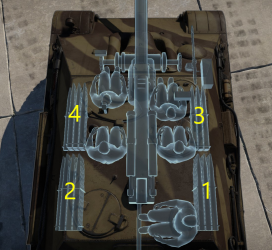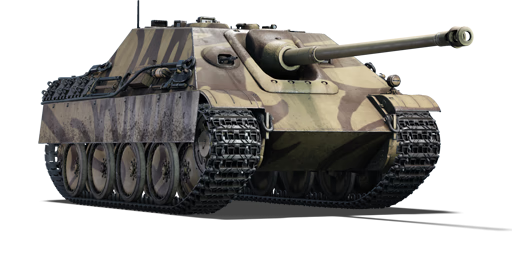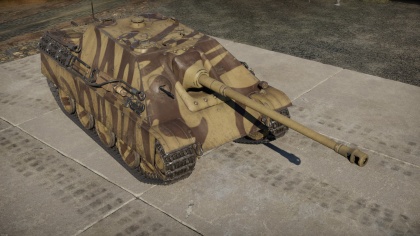Difference between revisions of "Jagdpanther G1"
(Added In-game description.) |
Inceptor57 (talk | contribs) |
||
| Line 1: | Line 1: | ||
{{Specs-Card|code=germ_panzerjager_panther}} | {{Specs-Card|code=germ_panzerjager_panther}} | ||
{{About | {{About | ||
| − | |about=tank destroyer '''{{PAGENAME}}''' | + | | about = tank destroyer '''{{PAGENAME}}''' |
| − | |other | + | | other |
| − | |usage-1=the premium version | + | | usage-1 = the premium version |
| − | |link-1=Bfw. Jagdpanther | + | | link-1 = Bfw. Jagdpanther |
| − | |usage-2=other | + | | usage-2 = the other vehicles of the family |
| − | |link-2=Panther (Family) | + | | link-2 = Panther tank (Family) |
}} | }} | ||
Revision as of 05:53, 31 May 2019
Contents
| This page is about the tank destroyer Jagdpanther G1. For the premium version, see Bfw. Jagdpanther. For the other vehicles of the family, see Panther tank (Family). |
Description
The Jagdpanther, Panzerjaeger Panther (8.8cm) Ausf.G1 is a rank IV German tank destroyer
with a battle rating of 6.3 (AB/RB/SB). It was introduced during the Closed Beta Test for Ground Forces before Update 1.41.
General info
Survivability and armour
Armour type:
- Rolled homogeneous armour
- Cast homogeneous armour (Gun mantlet)
| Armour | Front (Slope angle) | Sides (Slope angle) | Rear (slope angle) | Roof (Slope angle) |
|---|---|---|---|---|
| Hull | 80 mm (55°) Front glacis 60 mm (54°) Bottom glacis |
40 + 5 mm | 40 mm (24-26°) | 25 mm |
| Superstructure | Same as Hull | 50 mm (26-29°) | 40 mm (36°) | 25 mm (85°) |
Notes:
- Suspension wheels and tracks are 20 mm thick, though the interleaved pattern of the wheels provides cumulative 20 mm protection.
- Tracks and lower side of the hull are covered by 5 mm thick armour plate, protecting them from HEAT and HE shells.
- Rear parts of the upper side hull armour have tracks attached to it, adding additional 20 mm of armour.
- Belly armour is 20 mm thick.
Mobility
| Mobility characteristic | ||
|---|---|---|
| Weight (tons) | Add-on Armor weight (tons) |
Max speed (km/h) |
| 46.0 | N/A | 60 (AB) |
| 55 (RB/SB) | ||
| Engine power (horsepower) | ||
| Mode | Stock | Upgraded |
| Arcade | 994 | ___ |
| Realistic/Simulator | 619 | 700 |
| Power-to-weight ratio (hp/ton) | ||
| Mode | Stock | Upgraded |
| Arcade | 21.61 | __.__ |
| Realistic/Simulator | 13.46 | 15.22 |
Armaments
Main armament
| 88 mm PaK 43 | |||||
|---|---|---|---|---|---|
| Capacity | Vertical guidance |
Horizontal guidance |
Stabilizer | ||
| 60 | -8°/+14° | ±11° | N/A | ||
| Turret rotation speed (°/s) | |||||
| Mode | Stock | Upgraded | Prior + Full crew | Prior + Expert qualif. | Prior + Ace qualif. |
| Arcade | 7.04 | 9.75 | __.__ | __.__ | 13.93 |
| Realistic | 4.76 | 5.60 | __.__ | __.__ | 8.00 |
| Reloading rate (seconds) | |||||
| Stock | Prior + Full crew | Prior + Expert qualif. | Prior + Ace qualif. | ||
| 11.05 | __.__ | __.__ | 8.50 | ||
Ammunition
| Penetration statistics | |||||||
|---|---|---|---|---|---|---|---|
| Ammunition | Type of warhead |
Penetration in mm @ 0° Angle of Attack | |||||
| 10m | 100m | 500m | 1000m | 1500m | 2000m | ||
| PzGr 39/43 | APCBC | 236 | 234 | 221 | 207 | 193 | 180 |
| Sprgr | HE | 13 | 13 | 12 | 11 | 11 | 11 |
| Hl.Gr 39 | HEAT | 110 | 110 | 110 | 110 | 110 | 110 |
| PzGr 40/43 | APCR | 272 | 270 | 250 | 228 | 208 | 189 |
| Shell details | ||||||||||
|---|---|---|---|---|---|---|---|---|---|---|
| Ammunition | Type of warhead |
Velocity in m/s |
Projectile Mass in kg |
Fuse delay
in m: |
Fuse sensitivity
in mm: |
Explosive Mass in g (TNT equivalent): |
Normalization At 30° from horizontal: |
Ricochet: | ||
| 0% | 50% | 100% | ||||||||
| PzGr 39/43 | APCBC | 1,000 | 10.16 | 0.8 | 28 | 108.8 | +4° | 48° | 63° | 71° |
| Sprgr | HE | 820 | 9 | 0.1 | 0.5 | 698 | +0° | 79° | 80° | 81° |
| Hl.Gr 39 | HEAT | 600 | 7.64 | 0.0 | 0.3 | 1,100 | +0° | 62° | 69° | 73° |
| PzGr 40/43 | APCR | 1,130 | 7.3 | N/A | N/A | N/A | +1.5° | 66° | 70° | 72° |
Ammo racks

| Full ammo |
1st rack empty |
2nd rack empty |
3rd rack empty |
4th rack empty |
Visual discrepancy |
|---|---|---|---|---|---|
| 60 | 46 (+14) | 31 (+29) | 16 (+44) | 1 (+59) | Yes |
Left side empty: 31 (+29)
Machine guns
| 7.92 mm MG 34 | ||||||
|---|---|---|---|---|---|---|
| Hull mount | ||||||
| Capacity (Belt capacity) | Fire rate (shots/minute) |
Vertical guidance |
Horizontal guidance | |||
| 3,000 (150) | 900 | -5°/+10° | -10°/+5° | |||
Usage in battles
The Jagdpanther is best used defensively, to cover capture points and prevent their capture, and cover friendly tank advances. It's highly recommended to hide the lower frontal plate in this tank, as it has a frontal mounted transmission which will set the tank on fire if shot, as well as destroying the transmission. It's also strongly advised to use this tank at long range, and change position often.
It is important to keep in mind that the Jagdpanther's armour is sloped. Using it on the side of a hill facing the enemy is extremely dangerous since this would decrease the angle at which the frontal armour and sloped and thus negate a large part of its survival capabilities. By hiding behind buildings, trees and bushes, or on top of a hill, you optimise it's fighting capabilities. A well positioned Jagdpanther is very hard to destroy. In addition, using the Jagdpanther in a diamond position (with your right side facing the enemy) will mean that your most important crew members are better protected (driver, gunner, commander) since they are on the other side.
Pros and cons
Pros:
- Good mobility
- Excellent firepower with great long-range sniping abilities
- Armour of a Panther, so adequately armoured
- Unlike earlier Tank destroyers as the StuGs, Jagdpanzer IVs, Marders and Hetzer; it has 5 crew, rather than 4
- Front of the Jagdpanther makes it easy to attach a lot of camouflage to conceal the tank destroyer
- Gunsight has an enhanced zoom level
- Has fully functional hull machine gun
- Since it is an SPG, it requires fewer spawn points in RB than a normal tank
Cons:
- Bad reverse speed
- Panther hull armour isn't as effective against enemies it would face, rounds like the APDS from the 20 pdr can easily penetrate
- Front mounted transmission. Can catch fire and immobilizes vehicle when shot through lower frontal plate
- Like most Tank Destroyers, it lacks a turret
- A lot bigger than the StuG III, Jagdpanzer IVs, and the Hetzer, so may need to get used to the size and how to conceal it
- Penetration from the sides would often mean lethal as sides are littered with ammo
History
Development
Nazi Germany created the formidable 8.8 cm Pak 43 anti-tank gun, a longer version of the 8.8 cm Kwk 36. 2 attempts were made to fit this gun onto a self-propelled configuration, the first was Panzerjäger Tiger (P) Ferdinand (later Elefant) and the second was the Nashorn. However, the Ferdinand was too heavy and unreliable while the Nashorn was too small and underpowered to propel such a gun. The Jagdpanther was proposed in late 1942, as a tank destroyer from the Panther chassis that could mount the formidable 8.8 cm Pak 43 with good armour and speed. The tank destroyer was created and designated SdKfz 173 and was demonstrated to Hitler on October 1943. Production then started in January 1944 under the simpler name Jagdpanther by Hitler rather than using the longer 8.8 cm Pak 43/3 auf Panzerjäger Panther.
Throughout its production life of January 1944 to 1945, 415 total of these vehicles were made. MIAG produced 270 from January 1944 to the end of the war, MNH produced 112 from November 1944, and MBA produced 37 from December 1944. The supposed goal was 150 Jagdpanther produced a month, but Germany's deteriorating situation made this impossible. The Jagdpanthers were made in two variants, G1 and G2. The G1 had a small internally bolted main gun and modified Panther Ausf. An engine deck while the G2 had a larger simplified, outer bolted mantlet with a modified Panther Ausf. G engine deck. A proposal to mount the 12.8 cm Pak 80 was mentioned but never came around to production.
The Jagdpanther was a rather good design as a tank destroyer, it had a good power-to-weight ratio and had a gun that could destroy any Allied tank in service in the war. It did not suffer as much reliability problems due to being based on the later model Panther Ausf. G, which had most of the initial problems fixed. It also used an improved transmission and final drive (the two sources of most Panther issues) that was planned for the Panther II.
Combat Usage
Jagdpanthers were assigned to heavy tank destroyer battalions in the Western Front and Eastern Front, though most of the Jagdpanthers were sent to deal with the Soviet onslaught, where it first saw combat action. In Normandy, few of these vehicles were encountered by the Western Allies, though 12 were deployed in one occasion by the 654 schwere Panzerjäger-Abteilung against British units. One instance in July 30, 1944 saw three Jagdpanthers engage and destroy 10-11 Churchill tanks in about two minutes, though two of them were abandoned by the crew due to damage. The 654th was the only battalion to have a full complement of Jagdtigers of about 42 Jagdpanthers at the Western Front, the 559th battalion only had 10 to 14 of these vehicles. The largest concentration of the Jagdpanther on the west was during the Ardennes Offensive of about 20 vehicles combat-ready.
After the end of World War II with Nazi Germany's fall, the Jagdpanther and its original Panther configuration saw service with France. The Jagdpanthers served France from 1945 to the 1960s.
In-game description
"One of the most powerful and most successful German tank destroyers of World War II. This tank destroyer was designed by the company MIAG and was based on the Pz.Kpfw. V Panther tank. From October 1943 to April 1945, the MIAG, MNH, and MBA factories produced a total of 413 Jagdpanthers.
The Jagdpanther was mass-produced in three variants which differed in the following ways.
The first variant was the early version of the G1 self-propelled gun, produced from January to September 1944. These vehicles had an 88 mm 8,8 cm Pak 43/2 gun with a one-piece barrel. The gun was fixed to the front armor with bolts inside the vehicle. Anti-magnetic Zimmerit paste was applied to the vehicle's vertical surface in its characteristic squares. Also, this variant lacked a snorkel. The plate covering the engine either completely lacked an opening or had an opening which was plugged closed.
The second variant was the standard G1, which had an 88 mm 8,8 cm Pak 43/3 gun with a composite barrel. This tank destroyer also received a new gun mantlet. Zimmerit was not applied. Heat shields were installed around the exhaust pipe, and the guide wheels had a larger diameter. The third variant was the G2, which was equipped with a new gun mantlet reinforced with bolts. An armored plate taken from the Pz.Kpfw. V Ausf. G Panther tank was installed over the engine. The trenching tool and cleaning rod tube was moved to the rear.
This tank destroyer was a very effective weapon against all types of Soviet and Allied tanks. It was used on the Western and Eastern fronts until the end of the war.
For a heavy vehicle, the Jagdpanther had good speed and maneuverability. On the other hand, this self-propelled vehicle inherited a number of disadvantages from the tank it was based on, primarily low mechanical reliability and relatively thin side armor."
Media
Skin and Camouflages for the Jagdpanther in Warthunder Live.
See also
- Bfw. Jagdpanther - Premium version of the Jagdpanther.
External links
| Germany tank destroyers | |
|---|---|
| Pz. I Derivatives | Panzerjäger I |
| Pz. II Derivatives | 15cm sIG 33 B Sfl |
| Pz. 38(t) Derivatives | Marder III · Marder III H · Jagdpanzer 38(t) |
| Pz. III Derivatives | StuG III A · StuG III F · StuG III G · StuH 42 G |
| Pz. IV Derivatives | Jagdpanzer IV · Panzer IV/70(A) · Panzer IV/70(V) · Dicker Max · Nashorn · Brummbär · VFW |
| Pz. V Derivatives | Jagdpanther G1 · Bfw. Jagdpanther G1 |
| Pz. VI Derivatives | Sturer Emil · Elefant · Ferdinand · 38 cm Sturmmörser · Jagdtiger |
| Wheeled/Half-track | 8,8 cm Flak 37 Sfl. · Sd.Kfz.251/9 · Sd.Kfz.251/10 · Sd.Kfz.251/22 · Sd.Kfz.234/3 · Sd.Kfz.234/4 · 15 cm Pz.W.42 |
| ATGM Carrier | RakJPz 2 · RakJPz 2 (HOT) · Wiesel 1A2 |
| Other | Waffenträger · M109G · JPz 4-5 · Raketenautomat · VT1-2 |





